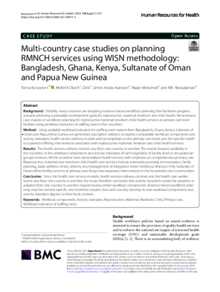Document
Multi-country case studies on planning RMNCH services using WISN methodology : Bangladesh, Ghana, Kenya, Sultanate of Oman and Papua New Guinea.
Identifier
DOI: 10.1186/s12960-021-00671-3
Source
Human Resources for Health. v. 19, 155
Contributors
Okech, Mollent., Author
Deki., Author
Asamani, James Avoka., Author
Mohamed, Nazar., Author
Nuruzzaman, M. d. , Author
Country
United Kingdom.
City
London
Publisher
BioMed Central Ltd.
Gregorian
2022-01-01
Language
English
Subject
English abstract
Background: Globally, many countries are adopting evidence-based workforce planning that facilitates progress towards achieving sustainable development goals for reproductive, maternal newborn and child health. We reviewed case studies on workforce planning for reproductive maternal newborn child health services at primary care level facilities using workload indicators of staffing need in five countries. Method: Using available workload indicators for staffing need reports from Bangladesh, Ghana, Kenya, Sultanate of Oman and Papua New Guinea, we generated descriptive statistics to explore comparable workload components and activity standards, health service delivery models with an emphasis on the primary care levels and the specific health occupations offering interventions associated with reproductive maternal, newborn and child health services. Results: The health services delivery models vary from one country to another. The results showed variability in the countries, in the workload components and activity standards of each regardless of facility level or occupational groups involved. All the countries have decentralized health services with emphasis on comprehensive primary care. Reproductive, maternal and new-born child health care services include antenatal, postnatal, immunization, family planning, baby wellness clinics, delivery and management of integrated minor childhood illnesses. Only Sultanate of Oman offers fertility services at primary care. Kenya has expanded interventions in the households and communities. Conclusion: Since the health care services models, health services delivery contexts and the health care worker teams vary from one country to another, the study therefore concludes that activity standards cannot be adopted or adapted from one country to another despite having similar workload components. Evidence based workforce planning must be context-specific, and therefore requires that each country develop its own workload components and activity standards aligned to their local contexts.
ISSN
1478-4491
Category
Journal articles

